
Today: FCC Robocalling Letter
FCC Sends Robocalling Letter
The Chief of the FCC’s Enforcement Bureau and its Chief Technology Officer sent a letter to the US Telecom Association expressing their gratitude for the work of USTelecom and the USTelecom Industry Traceback Group in the ongoing battle against illegal robocalls and harmful spoofed calls. The letter said that “[e]nding the twin abuses of illegal robocalls and illegal spoofed calls is the top consumer protection priority of the Federal Communications Commission. Accordingly, the Enforcement Bureau has focused on taking swift action against those who engage in these activities. We recognize that USTelecom's creation and continued operation of the USTelecom Industry Traceback Group has been instrumental in helping the Commission to achieve that goal.” They go on to say that “the USTelecom Industry Traceback Group has been able to provide a traceback chain reaching only one "hop" back from the originating carrier responsible for the harmful traffic-a significant improvement over the Bureau's initial traceback attempts, which might have required 10 or more individual subpoenas to complete. In addition, the information from USTelecom or its member organizations about illegal spoofing and robocall surges has resulted in dozens of active investigations. Even when those investigations have not culminated in formal enforcement actions, the information has been invaluable in helping Enforcement Bureau staff identify patterns and common sources of harmful call traffic.”
The FCC also sent “Official FCC Correspondence” letters to various voice providers that are not participating in these “traceback” efforts, including those the FCC has encouraged to do more to guard against illegal traffic. The letters seek specific information from the carriers about the procedures they have in place to detect and block spoofed calls by November 20, 2018.
Separately, Chairman Pai sent letters to various voice providers that apparently have not yet established concrete plans to protect their customers using the Signature-based Handling of Asserted Information Using toKENs (SHAKEN) and the Secure Telephone Identity Revisited (STIR) standards to do so without delay. His letters also pose questions to providers regarding implementation plans, highlighting the importance of private actors to combat illegal spoofing and unwanted and unlawful robocalls. Chairman Pai also thanked those companies that have committed to implementing a robust call authentication framework in the near term.
“Combatting illegal robocalls is our top consumer priority at the FCC. That’s why we need call authentication to become a reality—it’s the best way to ensure that consumers can answer their phones with confidence. By this time next year, I expect that consumers will begin to see this on their phones,” said Chairman Pai. “Carriers need to continue working together to make this happen and I am calling on those falling behind to catch up. I also thank the many providers that are well on their way toward implementation. Greater participation will ensure the system works for consumers, who expect real progress in combatting malicious spoofing and scam robocalls. If it does not appear that this system is on track to get up and running next year, then we will take action to make sure that it does.”
Under the SHAKEN/STIR framework, calls traveling through interconnected phone networks would be “signed” as legitimate by originating carriers and validated by other carriers before reaching consumers. The framework digitally validates the handoff of phone calls passing through the complex web of networks, allowing the phone company of the consumer receiving the call to verify that a call is from the person supposedly making it.
____________________________
The Regulatory Mix, Inteserra’s blog of telecom related regulatory activities, is a snapshot of PUC, FCC, legislative, and occasionally court issues that our regulatory monitoring team uncovers each day. Depending on their significance, some items may be the subject of an Inteserra Briefing.




